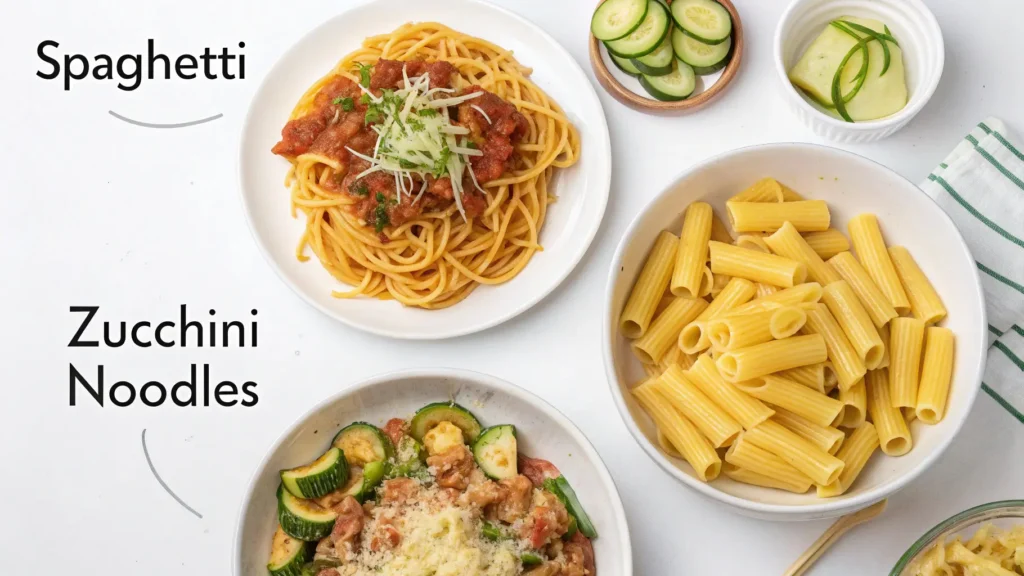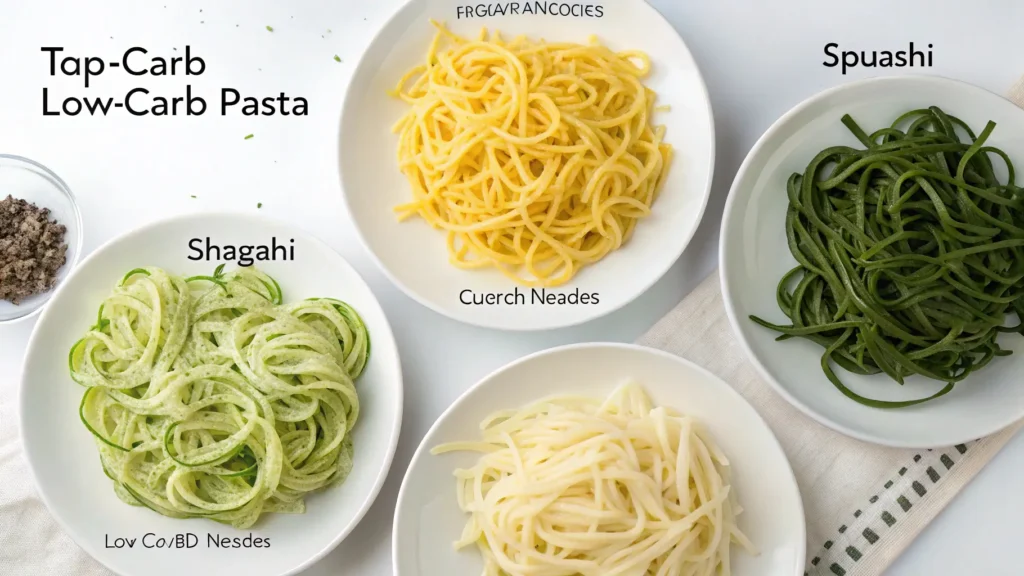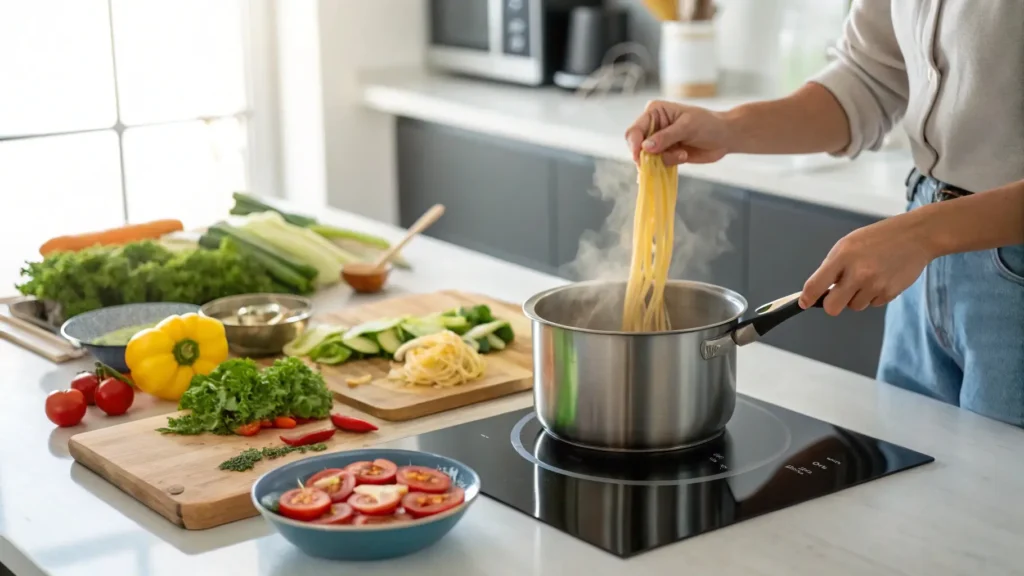When it comes to satisfying your pasta cravings without wrecking your carb count, choosing the right type of pasta is essential. But which pasta has the least carbs? With so many options on the market, ranging from vegetable-based alternatives to innovative konjac noodles, navigating the pasta aisle can be overwhelming.

This guide dives deep into low-carb pasta options, helping you understand what makes them different, how they compare nutritionally, and the best ways to prepare them. By the end, you’ll have a clear answer to which pasta has the least carbs and which ones fit your lifestyle best.
Let’s get started by understanding what makes pasta low-carb and why it’s gaining popularity.
Understanding Low-Carb Pasta Options
What Makes Pasta Low-Carb?
Low-carb pasta swaps traditional wheat flour for ingredients like konjac, chickpeas, or vegetables. These alternatives drastically reduce the carbohydrate content while often increasing fiber and protein levels. The key is replacing high-carb ingredients without compromising the texture and versatility of pasta dishes.
For instance, shirataki noodles, made from konjac root, are virtually carb-free, while vegetable spirals like zucchini or butternut squash provide a wholesome, natural option. Meanwhile, legumes like chickpeas and edamame are used to create higher-protein pasta with moderate carb levels.
Why Choose Low-Carb Pasta?
Switching to low-carb pasta has benefits beyond just cutting carbs. Many options are gluten-free, making them suitable for those with celiac disease or gluten intolerance. Additionally, they’re perfect for diets like keto or low-carb, allowing you to enjoy pasta without derailing your nutritional goals.
Moreover, low-carb pastas are often packed with fiber, helping to keep you fuller longer. They’re also an excellent way to include more vegetables in your meals, particularly when using options like zucchini spirals or spaghetti squash.
From a health perspective, reducing carb intake can stabilize blood sugar levels and support weight management. So whether you’re on a strict keto diet or simply want to make healthier food choices, low-carb pasta is worth considering.
In the next part, we’ll explore the top low-carb pasta options available and how they stack up against each other.
Top Low-Carb Pasta Options Available

Shirataki Noodles (Konjac-Based Pasta)
When discussing which pasta has the least carbs, shirataki noodles take the top spot. These translucent noodles, made from konjac root, boast zero net carbs, making them a staple for keto and low-carb diets.
Shirataki noodles are incredibly versatile and pair well with most sauces. They absorb flavors beautifully and mimic the texture of traditional pasta—though they can be slightly chewier. Quick to prepare, these noodles require a simple rinse and a few minutes in the pan to remove excess moisture.
One key tip? Make sure to rinse them thoroughly before cooking to eliminate the slight odor often associated with konjac-based products.
Hearts of Palm Pasta
Another fantastic alternative is hearts of palm pasta, made from the inner core of palm trees. With only 4 grams of carbs per serving, it’s an excellent option for those watching their carb intake.
Unlike shirataki noodles, hearts of palm pasta has a firmer texture and a subtle, slightly nutty flavor. It’s best used in light, vegetable-forward dishes or recipes where a firm bite enhances the experience. Hearts of palm pasta is also gluten-free and rich in nutrients, adding a healthy twist to your favorite meals.
Vegetable Spirals: Butternut Squash and Zucchini
Vegetable spirals, such as zucchini or butternut squash noodles, provide a natural and wholesome way to enjoy pasta-like dishes. These options are low in carbs—typically under 10 grams per serving—and packed with fiber and vitamins.
While they don’t mimic the texture of wheat pasta perfectly, their fresh, earthy taste can elevate dishes when paired with the right sauces. A quick sauté in olive oil with garlic and herbs transforms them into a satisfying base for any meal.
Nutritional Comparisons of Low-Carb Pasta Brands
Calorie and Carb Content of Leading Brands
If you’re wondering which pasta has the least carbs, shirataki noodles again come out on top with virtually no net carbs and under 10 calories per serving. Close behind are hearts of palm pasta and vegetable spirals, offering low-carb counts while contributing essential nutrients.
Brands like Palmini (hearts of palm) and Green Giant Veggie Spirals provide a middle ground between low carb and high nutrition. In contrast, legume-based pastas such as Banza (made from chickpeas) are higher in carbs, averaging 30 grams per serving, but compensate with added protein and fiber.
Protein and Fiber Benefits of Low-Carb Pasta
Many low-carb pasta options also deliver protein and fiber benefits. For example, chickpea and edamame-based pastas pack 10–20 grams of protein per serving, making them great for muscle repair and satiety. Vegetable-based options, though lighter on protein, are rich in fiber, supporting digestion and fullness.
Allergen and Dietary Considerations
If dietary restrictions are a concern, low-carb pastas cater to a wide range of needs. Shirataki noodles and veggie spirals are naturally gluten-free and vegan, while legume-based options are perfect for vegetarians. However, those with soy or legume allergies should avoid edamame or chickpea pastas.
Armed with these comparisons, you’re ready to make an informed decision about the best low-carb pasta for your lifestyle. Next, we’ll dive into how to cook these alternatives perfectly to enhance their flavor and texture.
Cooking and Preparing Low-Carb Pasta

Tips for Cooking Low-Carb Pasta Perfectly
Cooking low-carb pasta might seem intimidating at first, but with a few simple tricks, you can master the art. Start by thoroughly rinsing options like shirataki noodles to remove any residual odor. For vegetable spirals, lightly sauté them to maintain their crisp texture while reducing excess moisture.
With hearts of palm pasta, a quick boil or warm-up ensures the perfect consistency. Always avoid overcooking, as low-carb pastas can lose their texture more quickly than traditional ones. Using rich sauces like pesto or Alfredo can complement these pastas beautifully.
Common Mistakes to Avoid
The biggest pitfall when preparing low-carb pasta is using too much heat for too long. Unlike traditional pasta, these alternatives don’t require extended cooking times. Another mistake is failing to drain and dry shirataki or vegetable-based noodles before serving, which can lead to watery, diluted sauces.
To avoid disappointment, pair each pasta with the right recipe. Shirataki noodles, for example, are perfect for Asian-inspired dishes, while butternut squash spirals shine in creamy, nutmeg-infused sauces.
For more inspiration, check out “Lumache Pasta Recipes: Tips and Storage” for ideas you can adapt to low-carb varieties.
Exploring Health Benefits of Low-Carb Pasta
Low-Carb Pasta and Weight Management
For those aiming to manage their weight, low-carb pasta is a game-changer. By cutting out excess carbohydrates, it helps to reduce calorie intake while still providing a satisfying meal. Options like shirataki noodles and hearts of palm pasta, with their minimal carb counts, allow you to enjoy pasta dishes without guilt.
The fiber content in many low-carb options, such as vegetable spirals and edamame-based pasta, also plays a significant role in promoting satiety. This means you’ll feel full longer, reducing the temptation to overeat or snack unnecessarily.
Impact on Blood Sugar and Energy Levels
Low-carb pastas can help maintain steady blood sugar levels, which is especially beneficial for individuals with diabetes or those on ketogenic diets. Since these alternatives have a lower glycemic index than traditional wheat pasta, they cause fewer spikes and crashes in blood sugar.
By preventing these fluctuations, low-carb pasta options provide more consistent energy throughout the day. Whether you’re using them for a quick lunch or a hearty dinner, they support a balanced, nutritious diet.
Common Myths About Low-Carb Pasta
Myth: Low-Carb Pasta Tastes Bland
One of the biggest misconceptions is that low-carb pasta lacks flavor. In truth, it’s all about how you prepare it. For example, shirataki noodles absorb the taste of any sauce or seasoning, making them incredibly versatile. Vegetable spirals, on the other hand, bring their natural flavors to the dish, which can elevate simple recipes.
The key is pairing the right pasta with the right recipe. From rich Alfredo to zesty marinara, the possibilities are endless.
Myth: Low-Carb Pasta Is Hard to Cook
Another myth is that low-carb pasta is complicated to prepare. In reality, many of these options are easier and faster to cook than traditional pasta. Shirataki noodles require a quick rinse and sauté, while vegetable spirals are ready in minutes.
With a little practice and the right techniques, you can create delicious meals without the hassle. Plus, with pre-packaged options like hearts of palm pasta, convenience is never a concern.
In the final section, we’ll summarize the benefits of low-carb pasta and why it’s an excellent choice for anyone looking to maintain a healthier diet.
FAQs About Low-Carb Pasta
Which Pasta Has the Least Carbs?
If you’re searching for which pasta has the least carbs, shirataki noodles are the winner. With zero net carbs, they’re the top choice for keto dieters. Close contenders include hearts of palm pasta and vegetable spirals like zucchini or spaghetti squash, which also boast low carb counts.
Is Low-Carb Pasta Keto-Friendly?
Absolutely! Most low-carb pastas, such as shirataki and edamame-based options, are keto-friendly due to their minimal carb content. However, it’s important to double-check labels for hidden sugars or added ingredients that could interfere with your keto goals.
Does Low-Carb Pasta Taste Like Regular Pasta?
This depends on the type you choose. Shirataki noodles have a neutral taste but a slightly chewy texture, while hearts of palm pasta offers a firm bite with a mild, nutty flavor. Vegetable spirals often taste like the vegetables they’re made from, which can complement certain dishes. Although these alternatives might not perfectly mimic wheat pasta, their health benefits and variety make them worthwhile.

